brake light Citroen BERLINGO MULTISPACE RHD 2014.5 2.G Owner's Manual
[x] Cancel search | Manufacturer: CITROEN, Model Year: 2014.5, Model line: BERLINGO MULTISPACE RHD, Model: Citroen BERLINGO MULTISPACE RHD 2014.5 2.GPages: 276, PDF Size: 12.15 MB
Page 4 of 276

2
Berlingo_2_VP_en_Chap00a_Sommaire_ed02-2014.indd
key 18
Alarm 20d
oors
21
T
ailgate 23
Rear
roof flap
26
Central
locking
27
Instrument
panel
28
Adjusting
the time
29
W
arning lamps
30
Fuel gauge
38
Coolant
38
Under-inflation
detection
39
Service indicator
41
Lighting
dimmer
42
Steering
wheel
adjustment
43
Manual gearbox
43
Gear shift indicator
44
6-speed
electronic
gearbox
45
Stop
& Start
47
Starting and stopping
50
Hill start assist
51Lighting control
52
wipers 55
Cruise
control
57
Speed
limiter
60
Heating
/
Air
conditioning
manual
63 digital
65
Demisting
and
defrosting
67
Front
seats
69
Rear
bench seat
71
Rear seats
(5
seat version)
74
Rear seats
(7
seat version)
77
Modularity
84
Front
fittings
86
Modutop
roof
90
Roof
bars
95
Courtesy
lamps
96
Load space cover
(5
seat version)
97
Load space cover
(7
seat version)
101
Mirrors
103
Electric windows
105
rEAdY tO GO
3.
18-51 SAFE
t Y
5.
106-134
Location
Exterior 5
Interior
6
Instruments
and controls
8
T
echnical data -
Maintenance
12
Instruments
and controls
Left hand drive
13
Right hand drive
14
OVErVIEW
1.
4-14
Hazard warning lamps 106
Parking brake 106
Parking
sensors
107
Anti-lock
braking system
(ABS)
109
Emergency
braking
assistance
109a
SR and d SC
1
10
Grip control
1
11
Seat belts
1
13
Airbags
1
16
Child seats
120d
eactivating the passenger's front airbag
1
23
Recommended
seats
126
Installation
128
IS
o FIX seats
132
Child
lock
134
EASE OF uSE and
c
OMFO rt4.
52-105
E
c
O-
dr
IVI
n
G
2.
15-17
Environment 15
Eco-driving 16
The "V
isual search" (visual
index) section assists
you in finding the controls
and functions and their
associated
page numbers
on
the schematic outlines of
the
vehicle.
Contents
Page 10 of 276
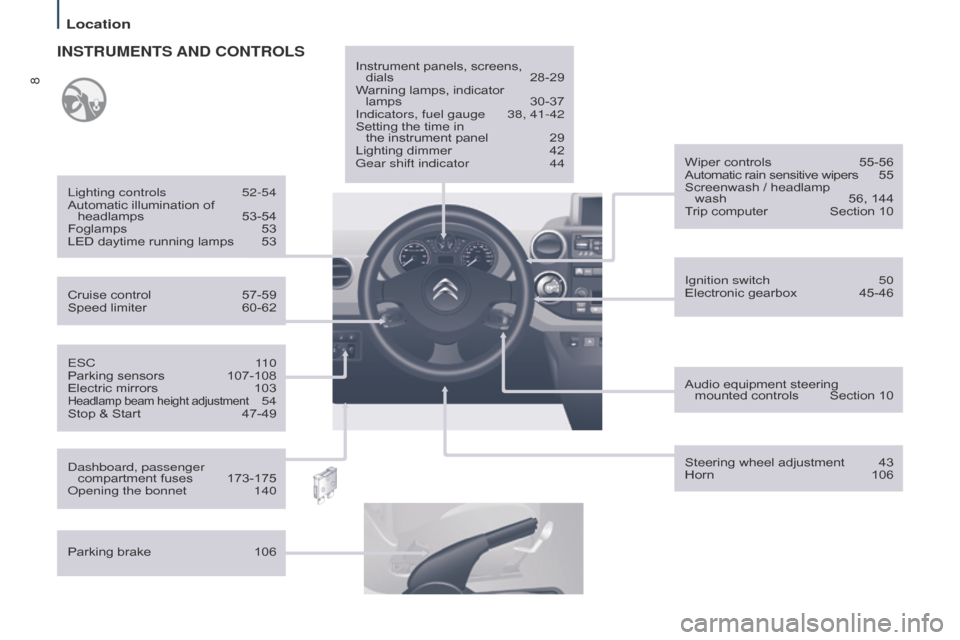
8
Berlingo_2_VP_en_Chap01_vue-ensemble_ed02-2014
ESC 110
Parking sensors 107-108
Electric
mirrors
103Headlamp beam height adjustment 54
Stop
&
Start
47-49
Cruise
control
57-59
Speed
limiter
60-62
Lighting controls
52-54
Automatic
illumination
of
headlamps
53-54
Foglamps
53
LED
daytime
running
lamps
53
InStruMEntS And c
O ntr OLS
dashboard, passenger
compartment fuses 173-175o
pening the bonnet
140
Parking
brake
106 Instrument
panels, screens,
dials
28-29
W
arning lamps, indicator
lamps
30-37
Indicators, fuel gauge
38, 41-42
Setting
the time in
the instrument panel
29
Lighting
dimmer
42
Gear shift indicator
44
Ignition switch
50
Electronic
gearbox
45-46
Wiper
controls
55-56
Automatic
rain sensitive wipers
5
5
Screenwash / headlamp
wash
56,
144
Trip computer
Section
10
Audio equipment steering
mounted
controls
Section
10
Steering wheel adjustment 43
Horn 106
Location
Page 12 of 276
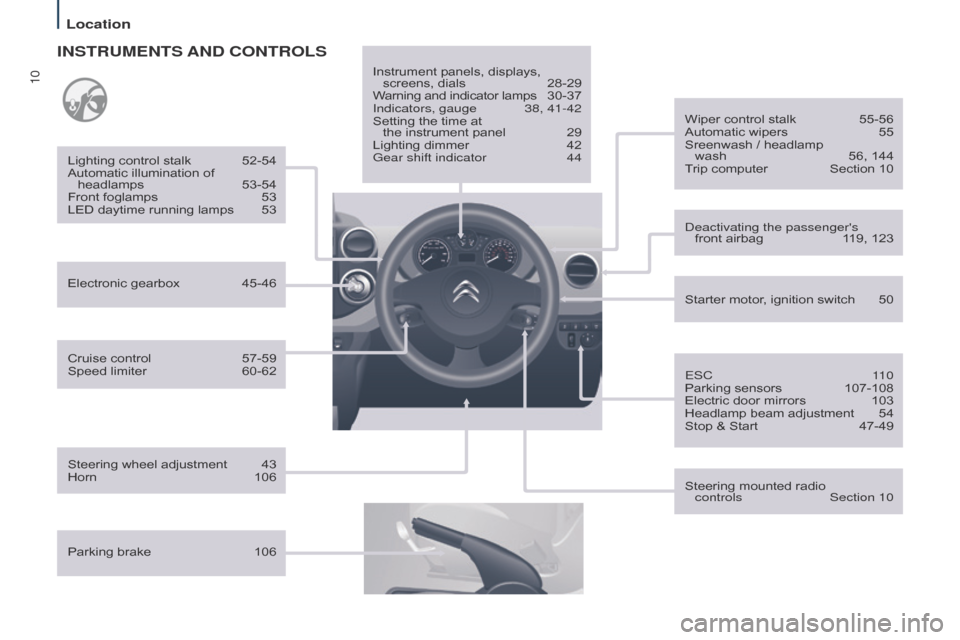
10
Berlingo_2_VP_en_Chap01_vue-ensemble_ed02-2014
Cruise control 57-59
Speed limiter 60-62
Lighting
control stalk
52-54
Automatic
illumination of
headlamps
53-54
Front
foglamps
53
LED
daytime running lamps
53
InStruMEntS And c
O ntr OLS
Parking brake 106Instrument panels, displays,
screens,
dials
28-29
W
arning and indicator lamps
3
0-37
Indicators, gauge
38, 41-42
Setting
the time at
the instrument panel
29
Lighting
dimmer
42
Gear shift indicator
44
Steering
wheel adjustment
43
Horn
106 Starter
motor, ignition switch
50
Wiper
control stalk
55-56
Automatic
wipers
55
Sreenwash
/ headlamp
wash
56,
144
Trip computer
Section
10
Steering mounted radio
controls
Section 10
d
eactivating the passenger's
front airbag
1
19, 123
ESC
1
10
Parking sensors
107-108
Electric
door mirrors
103
Headlamp
beam adjustment
54
Stop
& Start
47-49
Electronic
gearbox
45-46
Location
Page 14 of 276
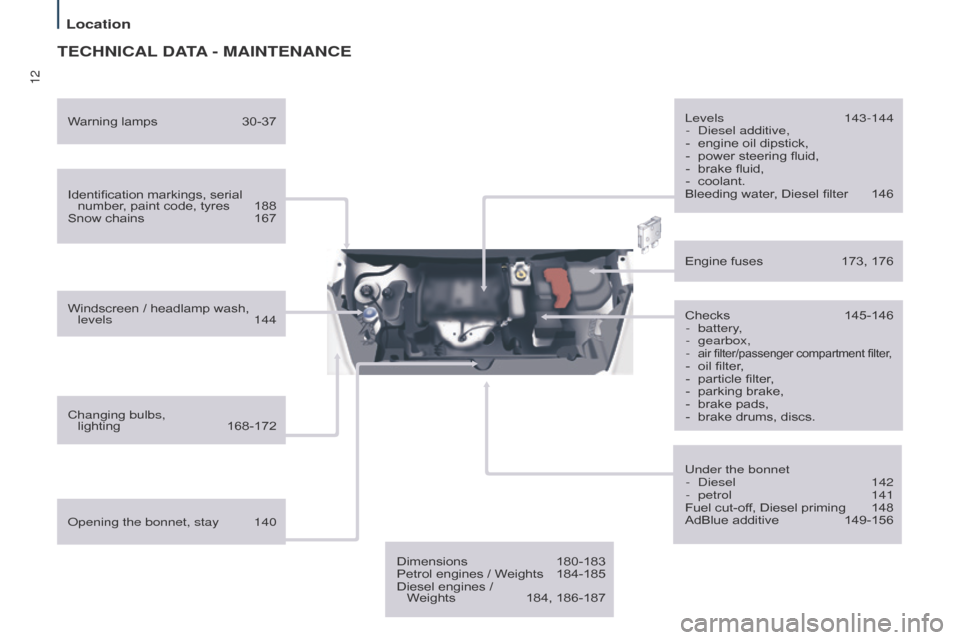
12
Berlingo_2_VP_en_Chap01_vue-ensemble_ed02-2014
tEcHnIcAL dAtA - MAI nt E n A nc E
Identification markings, serial number
, paint code, tyres 188
Snow
chains
167
Windscreen
/ headlamp wash,
levels
144
Changing bulbs,
lighting
168-172 Checks
145-146
-
battery
,
-
gearbox,
-
air filter/passenger compartment filter,- oil filter,
- particle filter,
-
parking
brake,
-
brake
pads,
-
brake
drums, discs.
Engine
fuses
173,
176
o
pening the bonnet, stay
140 Levels
143-144
-
d iesel additive,
-
engine
oil dipstick,
-
power
steering fluid,
-
brake
fluid,
-
coolant.
Bleeding
water, Diesel filter
146
W
arning
lamps
30-37
Under the bonnet-
d iesel
142
-
petrol
141
Fuel
cut-off, Diesel priming
148
AdBlue
additive
149-156
Dimensions
180-183
Petrol
engines
/
Weights
184-185
Diesel
engines
/
Weights
184,
186-187
Location
Page 18 of 276
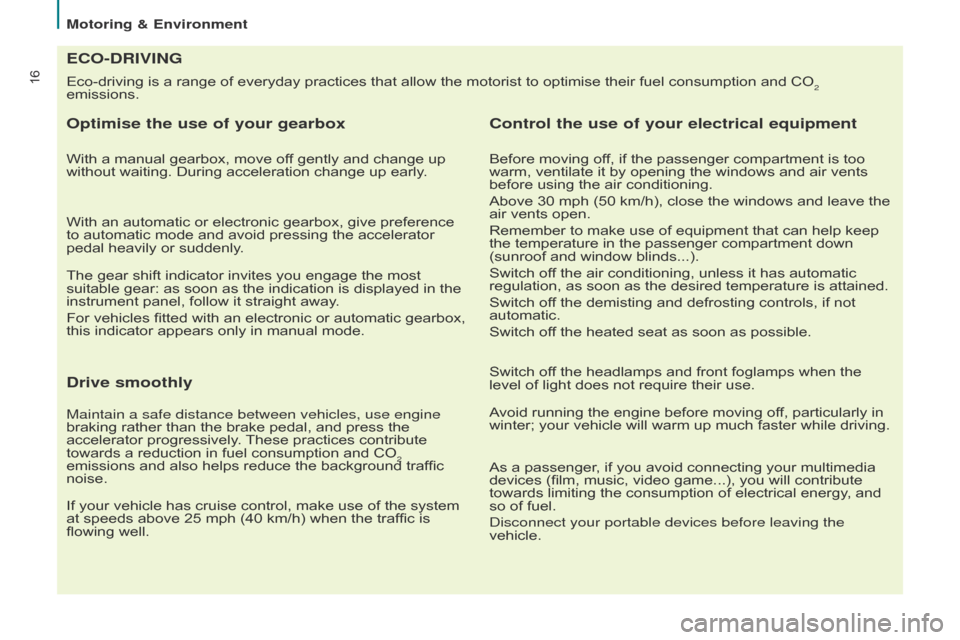
16Eco-driving is a range of everyday practices that allow the motorist to optimise their fuel consumption and CO2
emissions.
EcO-drIVInG
Optimise the use of your gearbox
With a manual gearbox, move off gently and change up without waiting. During acceleration change up early.
With
an automatic or electronic gearbox, give preference
to
automatic mode and avoid pressing the accelerator
pedal
heavily or suddenly.
The
gear shift indicator invites you engage the most
suitable
gear: as soon as the indication is displayed in the
instrument
panel, follow it straight away.
For
vehicles fitted with an electronic or automatic gearbox,
this
indicator appears only in manual mode.
drive smoothly
Maintain a safe distance between vehicles, use engine
braking rather than the brake pedal, and press the
accelerator
progressively.
These
practices contribute
towards
a reduction in fuel consumption and CO
2
emissions
and
also
helps
reduce
the
background traffic
noise.
If
your
vehicle
has
cruise
control,
make
use
of
the system
at
speeds
above
25
mph
(40
km/h)
when
the
traffic is
flowing
well.
control the use of your electrical equipment
Before moving off, if the passenger compartment is too warm, ventilate it by opening the windows and air vents
before
using the air conditioning.
Above
30 mph (50 km/h), close the windows and leave the
air
vents open.
Remember
to make use of equipment that can help keep
the
temperature in the passenger compartment down
(sunroof
and window blinds...).
Switch
off the air conditioning, unless it has automatic
regulation,
as soon as the desired temperature is attained.
Switch
off the demisting and defrosting controls, if not
automatic.
Switch
off the heated seat as soon as possible.
Switch
off the headlamps and front foglamps when the
level
of light does not require their use.
Avoid
running the engine before moving off, particularly in
winter;
your vehicle will warm up much faster while driving.
As
a passenger, if you avoid connecting your multimedia
devices
(film, music, video game...), you will contribute
towards
limiting the consumption of electrical energy, and
so
of fuel.
d
isconnect your portable devices before leaving the
vehicle.
Motoring & Environment
Page 49 of 276

Berlingo_2_VP_en_Chap03_Pret-a-partir_ed02-2014
47
StOP & StArt
The Stop & Start system puts the engine
temporarily on standby - STOP mode
- during stops in the traffic (red
lights,
traffic jams, or other...).
The
engine
restarts automatically - START
mode
- as soon as you want to move
of
f.
The
restart takes place instantly,
quickly
and silently.
Perfect for urban use, the Stop & Start
system
reduces fuel consumption and
exhaust
emissions as well as the noise
level
when stationary.
Operation
Going into engine StOP mode
The "E c O" warning lamp
comes
on in the instrument
panel and the engine goes
into
standby:
-
with a manual gearbox
, at speeds
below
12 mph (20 km/h), when you
put the gear lever into neutral and
release the clutch pedal,
-
with the 6-speed electronic gear
control gearbox
, at a speed below
5
mph (8 km/h), when you press
the
brake pedal or put the gear
lever into position
n .If
your vehicle is fitted with the system,
a
time counter calculates the sum of
the
periods in STOP
mode during a
journey
. It rests itself to zero every time
the
ignition is switched on with the key.
With the automatic gearbox
system,
for your comfort during
parking
manoeuvres, STOP
mode
is not available for a few seconds after
coming
out of reverse gear.
STOP
mode does not affect the
functionality of the vehicle, such as
braking,
power steering, for example.
n
ever refuel with the engine in
STOP
mode; you must switch off the
ignition with the key.Special cases: S t
OP
mode
unavailable
STOP
mode is not invoked when:
-
the driver's door is open,
-
the driver's seat belt is not
fastened,
-
the vehicle has not exceeded
6 mph
(10 km/h) since the last
engine
start using the key,
-
the
engine is needed to maintain
a
comfortable temperature in the
passenger
compartment,
-
demisting
is on,
-
some
special conditions (battery
charge,
engine temperature,
braking
assistance, ambient
temperature...)
where the engine
is needed to assure control of a
system.
In this case, the
"E c O"
warning
lamp flashes for a
few
seconds, then goes off.
t
his operation is perfectly normal.
Stop & Start
REadY To Go
3
Page 111 of 276
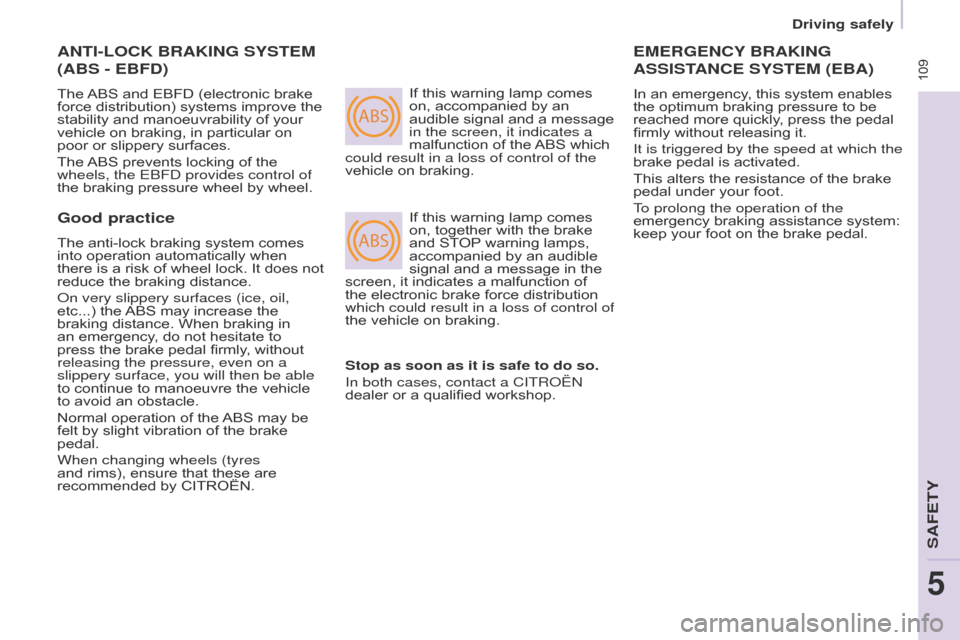
ABS
ABS
109
Berlingo_2_VP_en_Chap05_Securite_ed02-2014
AntI-LOcK BrAKInG SYStEM
(ABS - EBF d )
The ABS and EBFD (electronic brake force
distribution) systems improve the
stability
and manoeuvrability of your
vehicle
on braking, in particular on
poor
or slippery surfaces.
The
ABS
prevents locking of the
wheels, the EBF
d provides control of
the
braking pressure wheel by wheel.If
this warning lamp comes on,
accompanied by an
audible
signal and a message
in the screen, it indicates a
malfunction
of the
ABS
which
could result in a loss of control of the
vehicle
on braking.
If
this warning lamp comes
on,
together with the brake
and
STOP
warning lamps,
accompanied
by an audible
signal
and a message in the
screen,
it indicates a malfunction of
the
electronic brake force distribution
which could result in a loss of control of
the
vehicle on braking.
EMErGEncY BrAKInG
ASSIS t
A
nc E SYS t EM (EBA)
In an emergency, this system enables the optimum braking pressure to be
reached
more quickly, press the pedal
firmly
without releasing it.
It is triggered by the speed at which the
brake
pedal is activated.
This
alters the resistance of the brake
pedal
under your foot.
To prolong the operation of the
emergency
braking assistance system:
keep
your foot on the brake pedal.
Good practice
The anti-lock braking system comes into operation automatically when
there
is a risk of wheel lock. It does not
reduce
the braking distance.
o
n very slippery surfaces (ice, oil,
etc...)
the
ABS
may increase the
braking
distance. When braking in
an
emergency, do not hesitate to
press
the brake pedal firmly, without
releasing the pressure, even on a
slippery surface, you will then be able
to
continue to manoeuvre the vehicle
to
avoid an obstacle.
Normal
operation of the
ABS
may be
felt
by slight vibration of the brake
pedal.
When changing wheels (tyres
and
rims), ensure that these are
recommended
by CITROËN. Stop as soon as it is safe to do so.
In both cases, contact a CITR
o Ë n
dealer
or a qualified workshop.
driving safely
SaFETY
5
Page 146 of 276

Berlingo_2_VP_en_Chap07_Verification_ed02-2014
144
cooling system
Only use the fluid recommended by the manufacturer.
Otherwise,
you risk seriously damaging
your
engine.
When
the engine is warm, the
temperature
of the coolant is controlled
by
the engine fan.
As
this fan can
operate
with the ignition key removed
and
because the cooling system is
pressurised, wait for at least one hour
after the engine has stopped before
carrying
out any work.
Slacken
the cap by 1/4 of a turn to
release the pressure to prevent any
risk
of scalding. When the pressure
has
dropped, remove the cap and top
up
the level with coolant.
If
fluid has to be added frequently,
this
indicates a fault which must be
checked
by a CITROËN dealer as
soon
as possible.
Power steering fluid level
The vehicle must be parked on level ground with the engine cold. Unscrew
the cap integrated with the gauge and
check
the level which must be between
the
MIN and MAX marks. In
order to regenerate the filter, you are advised to drive at a speed higher
than
40 mph (60 km/h) for at least five minutes
as soon as possible, when
traffic
conditions permit (until the
message
disappears and the service
warning
lamp goes off).
d
uring regeneration of the particle
emission
filter, the noise of a relay
operating
may be heard under the
dashboard.
If
the message is still displayed and
if
the service warning lamp remains
on, contact a CITR
o Ë n dealer or a
qualified
workshop.
topping up
The
level
must
be
between
the
MIN
and
MAX
marks
on
the
expansion
bottle.
If
more
than
1
litre
of
fluid
is
required
to
top
up
the
level,
have
the
system
checked
by
a
CITROËN
dealer
or
a
qualified
workshop.
Screenwash and headlamp
wash level
For best quality cleaning and for your safety , we would advise that you use
products
of the CITROËN range.
For
optimum cleaning and to avoid
freezing,
this fluid must not be topped
up
or replaced with plain water.
Capacity
of the screenwash reservoir:
approximately
3 litres.
If
your vehicle is fitted with headlamp
washers, the capacity of the reservoir
is
6 litres.
diesel additive level
( d iesel with particle
emission filter)
topping up
This additive must be topped up by
a
CITROËN dealer or a qualified
workshop
without delay.
Waste products
avoid prolonged contact of used oil
with the skin.
Brake
fluid is harmful to health and
very
corrosive.
Do
not dispose of used oil, brake fluid
or coolant into drains or into the ground
but into the containers dedicated to this
use at a CITR
o Ë n dealer (France) or
an
authorised waste disposal site.
The
minimum
level
of
this
additive
is indicated by lighting of the service
warning
lamp,
accompanied
by
an
audible
signal
and
a
message
in
the
screen.
When this occurs with the engine
running it is due to the start of
saturation
of
the
particle
emission
filter
(exceptionally prolonged urban type
driving
conditions:
low
speed,
long
traffic
jams,
...).
Levels
Page 148 of 276
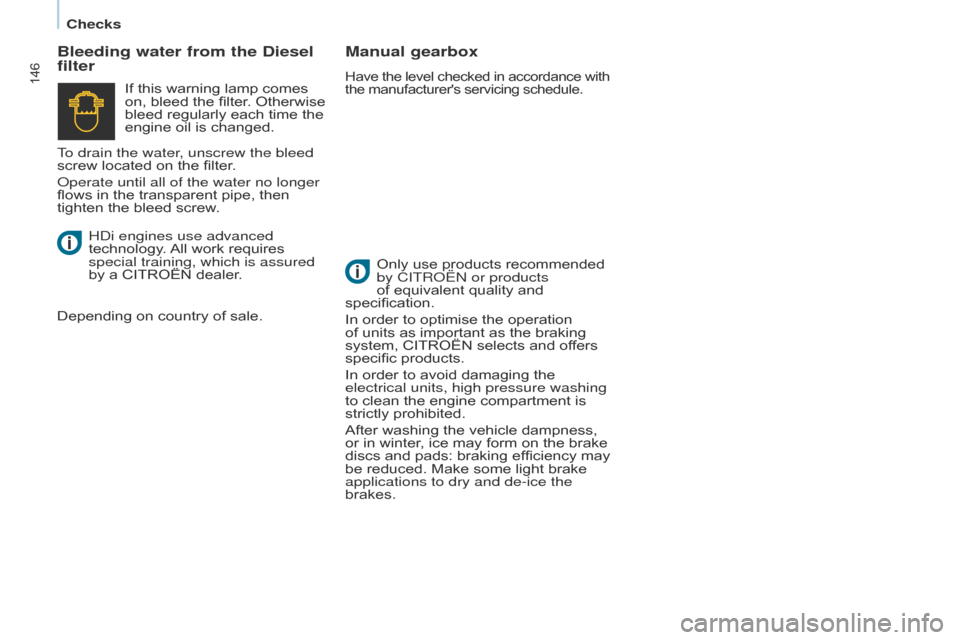
Berlingo_2_VP_en_Chap07_Verification_ed02-2014
146
Bleeding water from the diesel
filter Manual gearbox
Have the level checked in accordance with the
manufacturer's servicing schedule.
Only use products recommended by CITRo Ë n or products
of
equivalent quality and
specification.
In
order to optimise the operation
of
units as important as the braking
system,
CITROËN selects and offers
specific
products.
In
order to avoid damaging the
electrical units, high pressure washing
to
clean the engine compartment is
strictly
prohibited.
After
washing the vehicle dampness,
or
in
winter, ice may form on the brake
discs
and pads: braking efficiency may
be
reduced. Make some light brake
applications to dry and de-ice the
brakes.
If
this
warning
lamp
comes
on,
bleed
the
filter.
Otherwise
bleed
regularly
each
time
the
engine
oil
is
changed.
H
d
i engines use advanced
technology.
All
work
requires
special training, which is assured
by
a
CITROËN
dealer.
Depending
on
country
of
sale.
To drain the water, unscrew the bleed
screw
located
on
the
filter.
o
perate until all of the water no longer
flows
in
the
transparent
pipe,
then
tighten
the
bleed
screw.
checks
Page 162 of 276
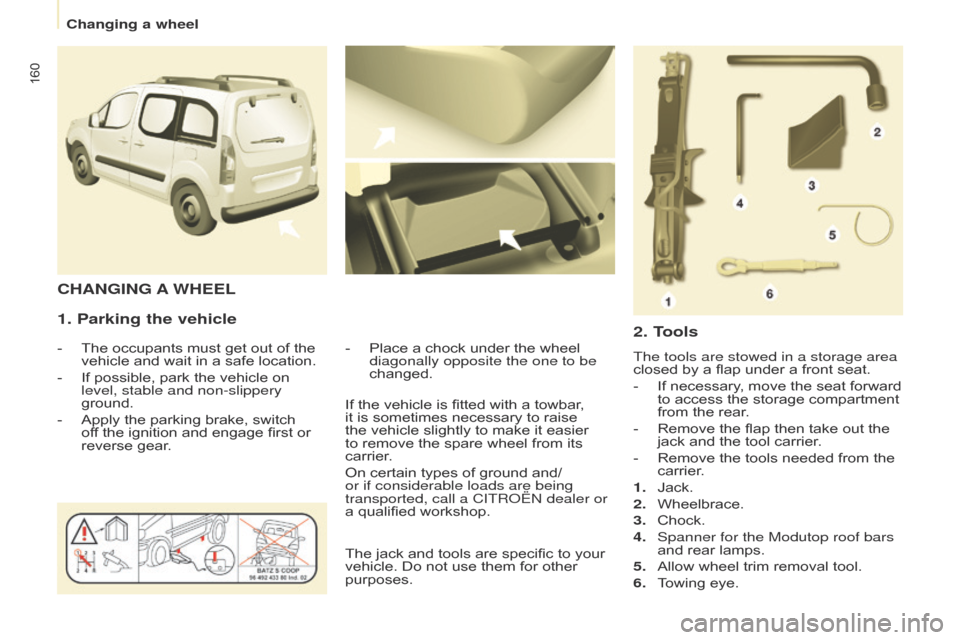
Berlingo_2_VP_en_Chap08_aide-rapide_ed02-2014
160
1. Parking the vehicle
- The occupants must get out of the vehicle
and wait in a safe location.
-
If
possible, park the vehicle on
level, stable and non-slippery
ground.
-
Apply
the parking brake, switch
of
f the ignition and engage first or
reverse
gear. -
Place a chock under the wheel diagonally opposite the one to be
changed.
cHAnGInG A WHEEL
2. t
ools
The tools are stowed in a storage area
closed by a flap under a front seat.
-
If
necessary, move the seat forward
to
access the storage compartment
from
the rear.
-
Remove
the flap then take out the
jack
and the tool carrier.
-
Remove
the tools needed from the
carrier
.
1.
Jack.
2.
Wheelbrace.
3.
Chock.
4.
Spanner for the Modutop roof bars
and
rear lamps.
5.
Allow
wheel trim removal tool.
6.
T
owing eye.
If
the
vehicle
is
fitted
with
a
towbar,
it
is
sometimes
necessary
to
raise
the
vehicle
slightly
to
make
it
easier
to
remove
the
spare
wheel
from
its
carrier
.
On
certain
types
of
ground
and/
or if considerable loads are being
transported, call a CITR
o
Ë
n
dealer or
a
qualified
workshop.
The
jack
and
tools
are
specific
to
your
vehicle.
Do
not
use
them
for
other
purposes.
Changing a wheel